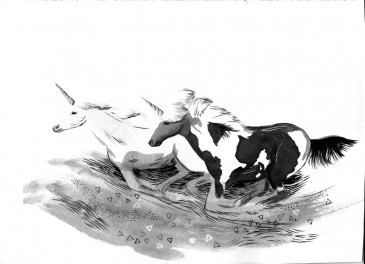
With a dark pop sound that both chills you to the bone and makes you want to dance, Toronto’s Austra—singer Katie Stelmanis, bassist Dorian Wolf and drummer/programmer Maya Postepski—have been garnering a lot of attention over their debut album, Feel It Break. Stelmanis is a classically trained musician who has a powerful and angelic voice and she’s the driving force behind the trio. Prior to Austra, Stelmanis recorded as a solo artist. With a sound similar to early Soft Cell or the Knife, the group draws on elements of goth and club culture to great effect. The dark, synth-heavy single “The Beat and the Pulse” showcases Stelmanis’ restrained yet powerful vocals at their finest, with an undulating synth sample creating spooky soundwaves behind her. Despite the chilly vibe of the record, Stelmanis was warm and friendly when Discorder called her up in Wales, where the band was currently stationed during a European tour.
Discorder: I came across your old Blogspot account with a bunch of names you were considering using before “Austra.” I’d never seen a band ask for name suggestions on their blog. What made Austra win out over choices like “Spellwork” or “Roma Lister”?
Katie Stelmanis: (laughs) Well, a lot of those other names were kind of jokes. We ended up going with Austra because, first off, it’s my middle name. The reason I liked it best was because it was a blank slate. It didn’t mean anything to anybody. It was something we could turn into whatever we wanted; we could create the imagery behind it. We didn’t want to be pigeon-holed by our name.
D: That’s great. I’ve been hearing a lot of different descriptions of your new album Feel It Break. It’s been called “gothic new-wave” and “goth-tinged baroque synth-pop.” What kind of sound are you going for?
KS: I’m not going for an [intentional] sound, per se. I’m never thinking, “Oh, I’m going to make an ‘80s song.” It’s a more natural process than that. I have a bunch of samples that I like to use on my computer repeatedly. A lot of the songs sound kind of ‘80s. That wasn’t the intention, but I was drawn to these chorus-infused samples which happen to have a very ‘80s characteristic.
D: You’ve said in the past you like to let your lyrics flow and not over-think them. Is that the case?
KS: Yeah, for sure. I don’t like to over-think them. I don’t consider myself to be a writer, so I like [the words] to come out naturally.
D: So in the recording process, did you do all the programming? Did Maya help with that or was it all you?
KS: I wrote all the songs. Maya helped a lot with arranging. The summer before we released the record, we went back and re-arranged a lot of the songs because many of them were old, and [we] brought them up to date. We improved the samples and the sample quality. Maya did a lot of drum programming. She’s really good at programming and producing, so she had a big part in rearranging and reworking a lot of the songs.
D: You provided guest vocals on Fucked Up’s The Chemistry of Common Life. How did you get connected with them?
KS: We both put out a record on [Toronto-based record company] the Blocks Recording Club. They heard my record, and they liked it and got in touch. We became friends over time.
D: Any good tour stories? Anything weird or interesting happen?
KS: Touring is full of those stories. We just went on tour in the States. We went to Whole Foods in Chicago for ten minutes and we got our van towed and had to pay $500 to get it out of impound. That was our first show of the tour; it was kind of a bummer.
D: If you had to pair Feel It Break with a book, like wine and food, what book would have a similar feel to the album?
KS: Maybe The Lord of the Rings.
D: Cool. I was thinking of The Lion, The Witch and the Wardrobe.
KS: That’s actually a better one.
D: This is the album the White Witch would be listening to in her palace, doing house cleaning.
KS: (laughs)
D: Compared to your solo work, Austra seems a lot more straightforward. How intentional was that? Were you trying to make your music more accessible?
KS: We were trying to make music that was easier to translate onto a live stage. We wanted music that was heavier on the drums and bass, so that people would physically feel it in a live setting. We just wanted to connect with people easier and that made the music poppier.
D: Your video for “The Beat and the Pulse” is great. I was a little surprised to find it was banned from YouTube. Do you have any comment on that?
KS: I wasn’t really surprised. YouTube doesn’t really allow female nudity and there was a lot of that in the video. I think it shows where North American values lie when you see how much hateful and violent stuff there is on YouTube. It’s funny when female nudity is deemed more offensive than that.
Austra opens for Cold Cave at the Electric Owl, July 21.

